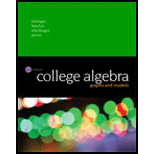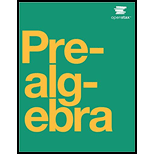
Pearson eText for College Algebra: Graphs and Models -- Instant Access (Pearson+)
6th Edition
ISBN: 9780136880264
Author: Marvin Bittinger, Judith Beecher
Publisher: PEARSON+
expand_more
expand_more
format_list_bulleted
Question
Chapter J.22, Problem 6E
To determine
The product of the expression
Expert Solution & Answer
Want to see the full answer?
Check out a sample textbook solution
Students have asked these similar questions
Nasir invested $415 into a savings account that earns 2.5% annual
interest.
Tiana invested $295 into a saving account that earns 6.8% annual
interest.
Who will have more money after 7 years? How much more money will
the person have?
Nasir invested $415 into a savings account that earns 2.5% annual
interest.
Tiana invested $295 into a saving account that earns 6.8% annual
interest.
Who will have more money after 7 years? How much more money will
the person have?
Solve for the variable.
62k = 7776k-
8
Chapter J Solutions
Pearson eText for College Algebra: Graphs and Models -- Instant Access (Pearson+)
Ch. J.1 - In Exercises 1-6, consider the numbers 23, 6, 3,...Ch. J.1 - In Exercises 16, consider the numbers 23, 6, 3,...Ch. J.1 - In Exercises 16, consider the numbers 23, 6, 3,...Ch. J.1 - In exercises 16, consider the numbers 23, 6, 3,...Ch. J.1 - In Exercises 16, consider the numbers 23, 6, 3,...Ch. J.1 - In Exercises 16, consider the numbers 23, 6, 3,...Ch. J.2 - Name the property illustrated by the sentence. 1....Ch. J.2 - Name the property illustrated by the sentence. 2....Ch. J.2 - Name the property illustrated by the sentence. 3....Ch. J.2 - Prob. 4E
Ch. J.2 - Prob. 5ECh. J.2 - Prob. 6ECh. J.2 - Prob. 7ECh. J.2 - Prob. 8ECh. J.2 - Prob. 9ECh. J.2 - Prob. 10ECh. J.3 - Classify the inequality as true or false. 1. 9 9Ch. J.3 - Prob. 2ECh. J.3 - Classify the inequality as true or false. 3. 265Ch. J.3 - Prob. 4ECh. J.3 - Prob. 5ECh. J.3 - Prob. 6ECh. J.4 - Simplify. 1. |98|Ch. J.4 - Prob. 2ECh. J.4 - Prob. 3ECh. J.4 - Prob. 4ECh. J.4 - Prob. 5ECh. J.4 - Prob. 6ECh. J.4 - Prob. 7ECh. J.4 - Prob. 8ECh. J.5 - Compute and simplify. 1. 8 (11)Ch. J.5 - Compute and simplify. 2. 310(13)Ch. J.5 - Prob. 3ECh. J.5 - Prob. 4ECh. J.5 - Prob. 5ECh. J.5 - Prob. 6ECh. J.5 - Prob. 7ECh. J.5 - Prob. 8ECh. J.5 - Prob. 9ECh. J.5 - Prob. 10ECh. J.5 - Prob. 11ECh. J.5 - Compute and simplify. 12. 1223Ch. J.5 - Prob. 13ECh. J.5 - Prob. 14ECh. J.5 - Prob. 15ECh. J.6 - Write interval notation. 1. {x| 5 x 5}Ch. J.6 - Prob. 2ECh. J.6 - Write interval notation. 3. {x | x 2}Ch. J.6 - Write interval notation. 4. {x | x 3.8}Ch. J.6 - Prob. 5ECh. J.6 - Prob. 6ECh. J.6 - Prob. 7ECh. J.6 - Prob. 8ECh. J.6 - Prob. 9ECh. J.6 - Write interval notation for the graph. 10.Ch. J.7 - Simplify. 1. 36Ch. J.7 - Prob. 2ECh. J.7 - Prob. 3ECh. J.7 - Prob. 4ECh. J.7 - Prob. 5ECh. J.7 - Prob. 6ECh. J.7 - Prob. 7ECh. J.7 - Prob. 8ECh. J.7 - Prob. 9ECh. J.7 - Prob. 10ECh. J.8 - Convert to scientific notation. 1. 18,500,000Ch. J.8 - Prob. 2ECh. J.8 - Prob. 3ECh. J.8 - Prob. 4ECh. J.8 - Convert to decimal notation. 5.4.3 108Ch. J.8 - Prob. 6ECh. J.8 - Convert to decimal notation. 7.6.203 1011Ch. J.8 - Prob. 8ECh. J.9 - Calculate. 1. 3 + 18 6 3Ch. J.9 - Calculate. 2. 5 3 + 8 32 + 4(6 2)Ch. J.9 - Calculate. 3. 5(3 8 32 + 4 6 2)Ch. J.9 - Calculate. 4. 16 4 4 2 256Ch. J.9 - Calculate. 5. 26 23 210 28Ch. J.9 - Calculate. 6. 4(86)243+2831+190Ch. J.9 - Calculate. 7. 64 [(4) (2)]Ch. J.9 - Prob. 8ECh. J.10 - Determine the degree of the polynomial. 1. 5 x6Ch. J.10 - Prob. 2ECh. J.10 - Prob. 3ECh. J.10 - Prob. 4ECh. J.10 - Prob. 5ECh. J.10 - Prob. 6ECh. J.10 - Prob. 7ECh. J.10 - Prob. 8ECh. J.11 - Add or subtract. 1. (8y 1) (3 y)Ch. J.11 - Add or subtract. 2. (3x2 2x x3 + 2) (5x2 8x ...Ch. J.11 - Prob. 3ECh. J.11 - Prob. 4ECh. J.11 - Prob. 5ECh. J.12 - Prob. 1ECh. J.12 - Prob. 2ECh. J.12 - Prob. 3ECh. J.12 - Prob. 4ECh. J.12 - Prob. 5ECh. J.12 - Prob. 6ECh. J.13 - Multiply. 1. (x + 3)2Ch. J.13 - Multiply. 2. (5x 3)2Ch. J.13 - Multiply. 3. (2x + 3y)2Ch. J.13 - Prob. 4ECh. J.13 - Multiply. 5. (n + 6) (n 6)Ch. J.13 - Prob. 6ECh. J.14 - Factor out the largest common factor. 1. 3x + 18Ch. J.14 - Prob. 2ECh. J.14 - Prob. 3ECh. J.14 - Prob. 4ECh. J.14 - Prob. 5ECh. J.14 - Prob. 6ECh. J.14 - Prob. 7ECh. J.14 - Prob. 8ECh. J.14 - Prob. 9ECh. J.14 - Prob. 10ECh. J.14 - Prob. 11ECh. J.14 - Prob. 12ECh. J.15 - Factor. 1. 8x2 6x 9Ch. J.15 - Factor. 2. 10t2 + 4t 6Ch. J.15 - Factor. 3. 18a2 51a + 15Ch. J.16 - Factor the difference of squares. 1. z2 81Ch. J.16 - Factor the difference of squares. 2. 16x2 9Ch. J.16 - Factor the difference of squares. 3. 7pq4 7py4Ch. J.16 - Factor the square of a binomial. 4. x2 + 12x + 36Ch. J.16 - Prob. 5ECh. J.16 - Factor the square of a binomial. 6. a3 + 24a2 +...Ch. J.16 - Factor the sum or the difference of cubes. 7. x3 +...Ch. J.16 - Factor the sum or the difference of cubes. 8. m3 ...Ch. J.16 - Prob. 9ECh. J.16 - Prob. 10ECh. J.17 - Prob. 1ECh. J.17 - Prob. 2ECh. J.17 - Prob. 3ECh. J.17 - Prob. 4ECh. J.17 - Solve. 5. 7y 1 = 23 5yCh. J.17 - Prob. 6ECh. J.17 - Prob. 7ECh. J.17 - Solve. 8. 5y 4 (2y 10) = 25Ch. J.18 - Prob. 1ECh. J.18 - Prob. 2ECh. J.18 - Prob. 3ECh. J.18 - Prob. 4ECh. J.18 - Prob. 5ECh. J.18 - Prob. 6ECh. J.19 - Prob. 1ECh. J.19 - Prob. 2ECh. J.19 - Prob. 3ECh. J.19 - Prob. 4ECh. J.19 - Prob. 5ECh. J.19 - Prob. 6ECh. J.19 - Prob. 7ECh. J.19 - Prob. 8ECh. J.20 - Prob. 1ECh. J.20 - Prob. 2ECh. J.20 - Prob. 3ECh. J.20 - Prob. 4ECh. J.20 - Prob. 5ECh. J.20 - Prob. 6ECh. J.21 - Prob. 1ECh. J.21 - Prob. 2ECh. J.21 - Prob. 3ECh. J.21 - Prob. 4ECh. J.21 - Prob. 5ECh. J.21 - Prob. 6ECh. J.22 - Prob. 1ECh. J.22 - Prob. 2ECh. J.22 - Prob. 3ECh. J.22 - Prob. 4ECh. J.22 - Prob. 5ECh. J.22 - Prob. 6ECh. J.23 - Prob. 1ECh. J.23 - Prob. 2ECh. J.23 - Prob. 3ECh. J.23 - Prob. 4ECh. J.23 - Prob. 5ECh. J.23 - Prob. 6ECh. J.24 - Simplify. 1. xyyx1y+1xCh. J.24 - Prob. 2ECh. J.24 - Prob. 3ECh. J.24 - Prob. 4ECh. J.24 - Simplify. 5. abba1a1b Note: b a = 1(a b)Ch. J.25 - Prob. 1ECh. J.25 - Prob. 2ECh. J.25 - Prob. 3ECh. J.25 - Prob. 4ECh. J.25 - Prob. 5ECh. J.25 - Prob. 6ECh. J.25 - Prob. 7ECh. J.25 - Prob. 8ECh. J.25 - Prob. 9ECh. J.25 - Prob. 10ECh. J.25 - Prob. 11ECh. J.25 - Prob. 12ECh. J.25 - Prob. 13ECh. J.25 - Prob. 14ECh. J.25 - Prob. 15ECh. J.25 - Prob. 16ECh. J.25 - Prob. 17ECh. J.25 - Prob. 18ECh. J.25 - Prob. 19ECh. J.25 - Prob. 20ECh. J.26 - Prob. 1ECh. J.26 - Prob. 2ECh. J.26 - Prob. 3ECh. J.26 - Prob. 4ECh. J.26 - Prob. 5ECh. J.26 - Prob. 6ECh. J.26 - Prob. 7ECh. J.26 - Prob. 8ECh. J.27 - Prob. 1ECh. J.27 - Prob. 2ECh. J.27 - Prob. 3ECh. J.27 - Prob. 4ECh. J.27 - Prob. 5ECh. J.27 - Prob. 6ECh. J.27 - Prob. 7ECh. J.27 - Convert to exponential notation. 8. x5Ch. J.27 - Prob. 9ECh. J.27 - Prob. 10ECh. J.27 - Prob. 11ECh. J.28 - Find the length of the third side of each right...Ch. J.28 - Find the length of the third side of each right...Ch. J.28 - Find the length of the third side of each right...Ch. J.28 - Find the length of the third side of each right...Ch. J.28 - Find the length of the third side of each right...
Knowledge Booster
Learn more about
Need a deep-dive on the concept behind this application? Look no further. Learn more about this topic, algebra and related others by exploring similar questions and additional content below.Similar questions
- Solve questionsarrow_forwardPatterns in Floor Tiling A square floor is to be tiled with square tiles as shown. There are blue tiles on the main diagonals and red tiles everywhere else. In all cases, both blue and red tiles must be used. and the two diagonals must have a common blue tile at the center of the floor. If 81 blue tiles will be used, how many red tiles will be needed?arrow_forwardFind the values of n, if the points (n + 1, 2n), (3n, 2n + 3) and (5n + 1,5n) are collinear. Find the value of k that the four points (4,1,2), (5, k, 6), (5,1,-1) and (7,4,0) are coplanar. Find the value of r if the area of the triangle is formed by the points (-3,6),(4,4) and (r,-2) is 12 sq units. Find the volume of tetrahedron whose vertices are A(1,1,0), B(-4,3,6), C(-1,0,3) and D(2,4,-5).arrow_forward
- - Consider the following system of linear equations in the variables a,b,c,d: 5a-3b 7c - 2d = 2 2ab 2c+ 5d = -3 → (*) 4a 3b 5d = 3 6a b+2c+ 7d = −7 (a) Solve the system (*) by using Gauss elimination method. (b) Solve the system (*) by using Cramer's rule method.arrow_forwardSolve for a 25 55 30 a=?arrow_forward9:41 … 93 Applying an Exponential Function to Newton's Law of Cooling 60. Water in a water heater is originally Aa ← 122°F. The water heater is shut off and the water cools to the temperature of the surrounding air, which is 60°F. The water cools slowly because of the insulation inside the heater, and the value of k is measured as 0.00351. a. Write a function that models the temperature T (t) (in °F) of the water t hours after the water heater is shut off. b. What is the temperature of the water 12 hr after the heater is shut off? Round to the nearest degree. c. Dominic does not like to shower with water less than 115°F. If Dominic waits 24 hr. will the water still be warm enough for a shower? Mixed Exercises ger-ui.prod.mheducation.comarrow_forward
- Please use the infinite series formula and specify how you did each step. Thank you.arrow_forward8) Solve the given system using the Gaussian Elimination process. 2x8y = 3 (-6x+24y = −6arrow_forward7) Solve the given system using the Gaussian Elimination process. (5x-4y = 34 (2x - 2y = 14arrow_forward
- 33 (a) (b) Let A(t) = = et 0 0 0 cos(t) sin(t) 0-sin(t) cos(t)) For any fixed tЄR, find det(A(t)). Show that the matrix A(t) is invertible for any tЄ R, and find the inverse (A(t))¹.arrow_forwardUse the infinite geometric sum to convert .258 (the 58 is recurring, so there is a bar over it) to a ratio of two integers. Please go over the full problem, specifying how you found r. Thank you.arrow_forwardH.w: Find the Eigen vectors for the largest Eigen value of the system X1+ +2x3=0 3x1-2x2+x3=0 4x1+ +3x3=0arrow_forward
arrow_back_ios
SEE MORE QUESTIONS
arrow_forward_ios
Recommended textbooks for you
 College Algebra (MindTap Course List)AlgebraISBN:9781305652231Author:R. David Gustafson, Jeff HughesPublisher:Cengage Learning
College Algebra (MindTap Course List)AlgebraISBN:9781305652231Author:R. David Gustafson, Jeff HughesPublisher:Cengage Learning Algebra: Structure And Method, Book 1AlgebraISBN:9780395977224Author:Richard G. Brown, Mary P. Dolciani, Robert H. Sorgenfrey, William L. ColePublisher:McDougal Littell
Algebra: Structure And Method, Book 1AlgebraISBN:9780395977224Author:Richard G. Brown, Mary P. Dolciani, Robert H. Sorgenfrey, William L. ColePublisher:McDougal Littell Elementary AlgebraAlgebraISBN:9780998625713Author:Lynn Marecek, MaryAnne Anthony-SmithPublisher:OpenStax - Rice University
Elementary AlgebraAlgebraISBN:9780998625713Author:Lynn Marecek, MaryAnne Anthony-SmithPublisher:OpenStax - Rice University Algebra & Trigonometry with Analytic GeometryAlgebraISBN:9781133382119Author:SwokowskiPublisher:Cengage
Algebra & Trigonometry with Analytic GeometryAlgebraISBN:9781133382119Author:SwokowskiPublisher:Cengage

College Algebra (MindTap Course List)
Algebra
ISBN:9781305652231
Author:R. David Gustafson, Jeff Hughes
Publisher:Cengage Learning

Algebra: Structure And Method, Book 1
Algebra
ISBN:9780395977224
Author:Richard G. Brown, Mary P. Dolciani, Robert H. Sorgenfrey, William L. Cole
Publisher:McDougal Littell

Elementary Algebra
Algebra
ISBN:9780998625713
Author:Lynn Marecek, MaryAnne Anthony-Smith
Publisher:OpenStax - Rice University


Algebra & Trigonometry with Analytic Geometry
Algebra
ISBN:9781133382119
Author:Swokowski
Publisher:Cengage

Introduction to Integers,Maths - What are integers - English; Author: Mathispower4u;https://www.youtube.com/watch?v=04pURxo-iu0;License: Standard YouTube License, CC-BY
Integers-Middle School Math; Author: MooMooMath and Science;https://www.youtube.com/watch?v=DGWcWtqM_yk;License: Standard YouTube License, CC-BY